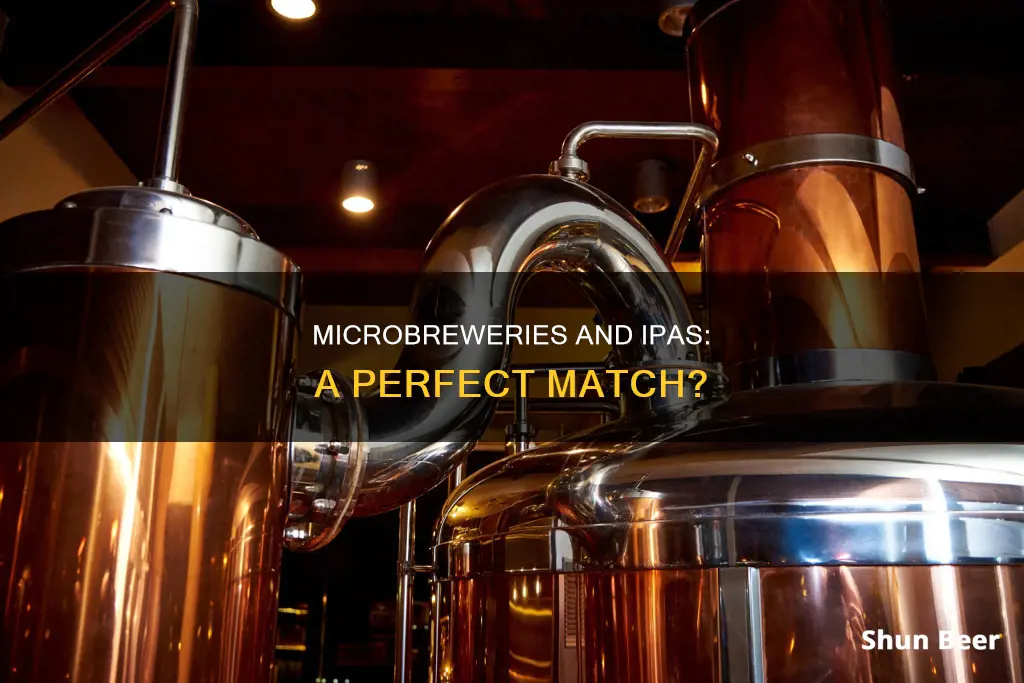
India Pale Ales (IPAs) are a hoppy beer style within the broader category of pale ales. They were originally crafted for British troops in India during the 19th century and have since become a popular style of beer worldwide. IPAs are characterised by their high hops content, which gives them a signature bitterness, as well as higher alcohol content when compared to other beers. The craft beer movement has brought creative and bold takes on the traditional flavour profile, and today, IPAs are often associated with microbreweries and craft beer.
What You'll Learn

IPAs are popular because they are representative of the craft beer movement
India Pale Ales (IPAs) are popular because they are representative of the craft beer movement. IPAs are a hoppy beer style within the broader category of pale ales. The modern approach to hoppy beer is not a declaration of bitterness but an exploration of the world of fruity flavours that can be derived from hops. IPAs are popular because they changed the game for craft beer and, though they may not be the saviour of the industry, they are not the enemy either.
IPAs originated in Britain in the 19th century as a riff on the standard pale ale, adding additional hops and increasing the alcohol content. They were originally crafted for British troops stationed in India, hence the name. Theories vary as to why the recipe was altered, but some suggest that the more robust beer was an effort toward food safety in the hot weather, while others suggest that the softer flavours and carbonation of a classic pale ale wouldn't survive the long trip from England, so the punchier hops and extra alcohol were added to keep the troops happy.
IPAs surged in popularity throughout the 2010s as the craft beer movement brought forth creative and bold takes on the traditional flavour profile. IPAs are now one of the most popular beer styles in the UK and it is estimated that over 40% of craft beer brewed in the United States can be classified as an IPA.
The popularity of IPAs can be attributed to a variety of factors, including cultural influence, the unique flavour profile, and the relatively quick and easy brewing process. IPAs are also popular among craft brewers because they are forgiving when it comes to fermentation and maturation temperatures, and the hops can cover up some minor mistakes and off-flavours.
The IPA style is constantly evolving, with new variations such as the New England IPA, the milkshake IPA, and the Brut IPA. Whether you're looking for a traditional take or a creative modern twist, there is an IPA to suit every taste.
Guinness Beer: A Source of Vitamins?
You may want to see also

IPAs are easier to make than lagers
IPAs and lagers are two of the most popular beer styles in the world. While both have been around for centuries, they have distinct histories, flavours, and brewing processes. One of the key differences between the two is the ease of production, with IPAs being generally easier to make than lagers.
The primary reason for this ease lies in the fermentation process and the type of yeast used. IPAs are fermented at warmer temperatures, typically between 57-68°F (14-20°C), which is closer to room temperature. The yeast used in IPAs, Saccharomyces cerevisiae, thrives at these warm temperatures and rises to the top of the liquid during fermentation, forming a top-fermenting or top-forming yeast layer. This yeast works relatively quickly, and IPAs can be fermented in about a week.
On the other hand, lagers are fermented at cooler temperatures, with a preferred range of 45-54°F (7-12°C). Lager yeast, Saccharomyces pastorianus, sinks to the bottom of the liquid during fermentation and works more slowly. Lagers also require a longer fermentation period, typically taking 4 to 8 weeks. Additionally, the traditional method of lagering, or storing the beer at even colder temperatures of 32 to 36°F (0 to 2°C), further extends the production time. This additional step of cold storage is not required for IPAs, making the overall process faster and less complex.
The different fermentation requirements of IPAs and lagers have significant implications for the breweries' equipment and storage needs. IPAs, with their faster fermentation and shorter maturation time, are less demanding in terms of specialised equipment and space. Lagers, on the other hand, require more time, storage capacity, and a cooling system to maintain the desired temperatures during fermentation and lagering. These additional requirements translate to higher costs for lager production.
The advent of refrigeration has made lagers the dominant global beer style, as they are well-suited for quenching thirst on hot days. However, the increased time, storage, and financial requirements of lager production pose challenges, especially for small-scale craft breweries. As a result, craft breweries often favour the production of ales, including IPAs, as they are less costly and time-consuming to produce, allowing breweries to experiment with different flavours and styles while also meeting consumer demands.
Guinness Beer: An IPA or Not?
You may want to see also

IPAs are versatile and can be made in a variety of ways
India Pale Ales (IPAs) are a versatile style of beer that can be crafted in a variety of ways, catering to diverse tastes and preferences. While IPAs are known for their prominent hoppy character, the level of bitterness can vary significantly across different interpretations of the style.
The versatility of IPAs is evident in the range of flavour profiles that brewers have achieved. While some IPAs showcase citrusy notes, others exhibit herbaceous or evergreen characteristics. The use of specific hops, such as Citra hops, can lend berry, melon, or grapefruit flavours to the beer. Brewers can also emphasise certain flavours by using techniques like dry-hopping, which amplifies fruity or piney notes without adding bitterness.
The versatility of IPAs extends beyond flavour profiles. IPAs can vary in alcohol content, ranging from session IPAs with lower alcohol levels to double or imperial IPAs with higher ABV. The term "double" in double IPAs refers to the increased amount of ingredients, particularly hops, resulting in elevated alcohol content and a more robust hop character. Additionally, IPAs can be categorised by region, with variations such as American, West Coast, and New England IPAs, each boasting distinct characteristics.
The New England IPA, for instance, is unfiltered, resulting in a hazy appearance, and exhibits low bitterness with intense fruity flavours. On the other hand, West Coast IPAs are known for their crisp, clean, and sharp profiles, showcasing bold tropical fruit notes. British IPAs, while less popular today, are characterised by maltiness, bitterness, and a more singular flavour profile.
Furthermore, IPAs can be crafted to cater to specific preferences, such as the "East Coast" style IPA, which serves as a middle ground between British and West Coast IPAs, emphasising piney hop flavours with a solid malt backbone. Brewers have also experimented with ingredients like oats to create "oat IPAs," which offer a softer, cozier mouthfeel while retaining fruity hop flavours.
The versatility of IPAs has contributed to their enduring popularity and their status as a signature style for craft brewers worldwide. Brewers continue to innovate and explore new interpretations of the style, ensuring that IPAs remain a dynamic and exciting category of beer.
Shiner Bock: IPA or Not?
You may want to see also

IPAs are profitable for breweries
India Pale Ales (IPAs) have become increasingly popular over the years, with a quarter of the top 20 beers on Beer Advocate's list of the best beers in the world being IPAs. This popularity makes IPAs a profitable product for breweries.
IPAs were originally crafted for British troops stationed in India during the 19th century, as a riff on the standard pale ale. The addition of more hops and an increase in alcohol content created a more robust beer, which could survive the long trip from England to India.
The style became popular in the 2010s as the craft beer movement brought creative and bold takes on the traditional flavour profile. IPAs are known for their high hops content, which lends the brew a signature bitterness, but they can also have nuances ranging from citrusy to herbaceous and even evergreen.
The popularity of IPAs has led to the development of different styles, such as the West Coast IPA, New England IPA, and Double IPA. These variations offer something for everyone, from those who prefer a more bitter and crisp beer to those who want a smoother and fruitier option.
IPAs are also relatively easy to make, as they are a top-fermented beer that does not require ageing. This quick fermentation process allows breweries to produce more beer in a shorter amount of time, increasing profitability.
In conclusion, the enduring popularity of IPAs, combined with their relatively easy production, makes them a profitable product for breweries. With IPAs being one of the most popular beer styles in the world, it is likely that they will continue to be a significant source of revenue for breweries in the future.
Guinness Beer: Sweet or Not?
You may want to see also

IPAs are a style of beer that is constantly evolving
The IPA has undergone a significant evolution since its early days as an export beer. In the 19th century, it became popular in Britain, with brewers like Bass and Allsopp's developing strongly-hopped pale ales. By the 20th century, IPA had spread to other colonial countries, and American, Australian, and Canadian brewers began producing their own versions. The style continued to gain momentum in the craft beer movement of the 21st century, with the US-influenced IPA becoming one of the most popular beer styles in the UK.
The versatility of IPAs is evident in the various types that have emerged, such as the West Coast IPA, known for its fruity, tropical notes, and the New England IPA, which is unfiltered, hazy, and less bitter. The East Coast IPA, a bridge between British and West Coast styles, emphasises piney hop flavours. Brewers have also experimented with ingredients like oats in oat IPAs, creating a "soft" and "lazy" mouthfeel. The lactose IPA, or "milkshake IPA," adds sweetness without lactose, and the Belgian IPA incorporates Belgian yeast for sweet, bready notes.
The IPA style continues to innovate and diversify, defying conventions and challenging expectations. Brewers are pushing the boundaries of hoppy flavours, creating IPAs that showcase notes of berries, melon, grapefruit, and more. The Double or Imperial IPA takes the style to the next level, with a higher hop concentration and increased alcohol content. Even within the IPA category, there are sub-styles like the Black IPA, which has a darker malt flavour, and the Brut IPA, a crisp, dry variation.
The evolution of IPAs is driven by a combination of factors, including cultural influences, the craft beer movement, and the desire to showcase intense flavours and aromas. IPAs have become a symbol of craft brewers worldwide, with each region adding its unique twist to the style. While some may argue that IPAs are too bitter or too sweet, the style's adaptability means there is an IPA to suit every palate. Whether you prefer the crisp bitterness of a West Coast IPA or the juicy, hazy character of a New England IPA, the ever-evolving world of IPAs has something for everyone.
Guinness Beer: Available in Kolkata?
You may want to see also
Frequently asked questions
India Pale Ale (IPA) is a hoppy beer style within the broader category of pale ales. IPAs are known for their high hops content, which lends the brew a signature bitterness. However, IPAs offer more than just bite, with nuances that can range from citrusy to herbaceous and even evergreen.
No, IPAs are produced by a range of breweries, from microbreweries to larger, more established breweries. In the late 20th century, craft beer revolution in the United States, brewers began seeking out old beer styles that had fallen out of vogue, and the traditional IPA style with its intense flavour and aroma was well-suited to showcase American hops.
IPAs are one of the most popular craft beer styles, with their popularity surging in the 2010s. In 2019, a survey found that Brewdog's Punk IPA was the best-selling craft beer in the UK. It is estimated that over 40% of craft beer brewed in the United States can be classified as an IPA.







